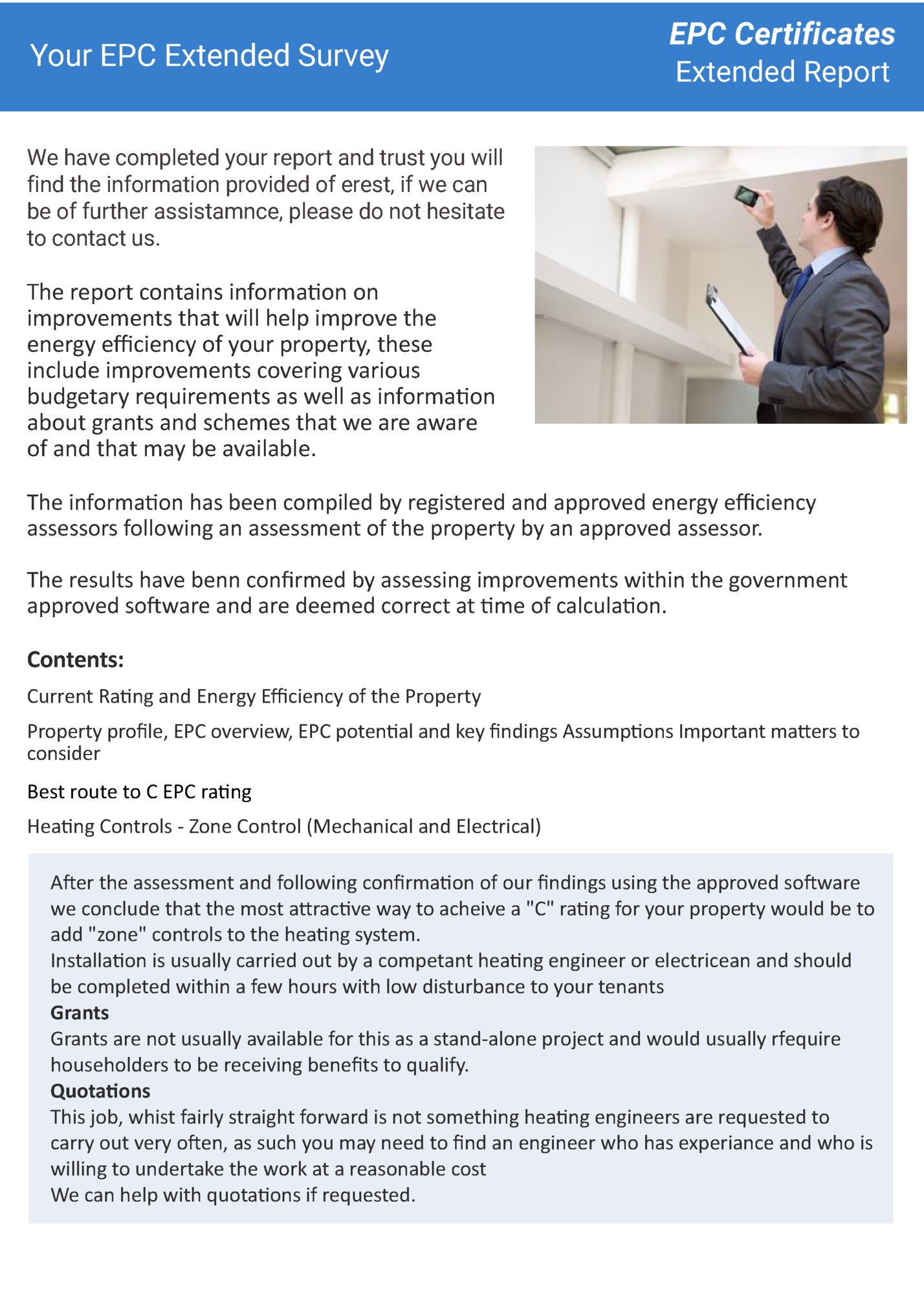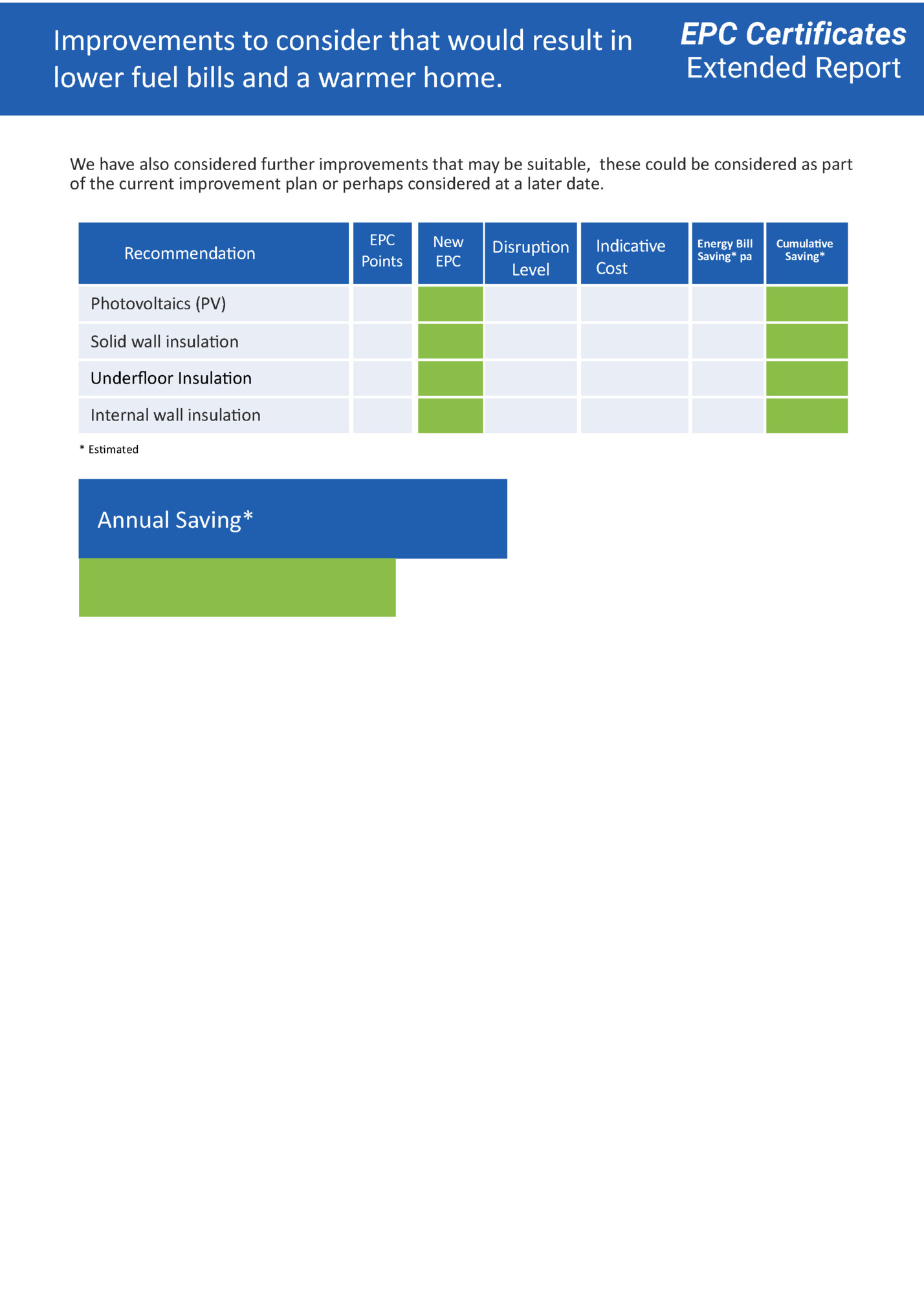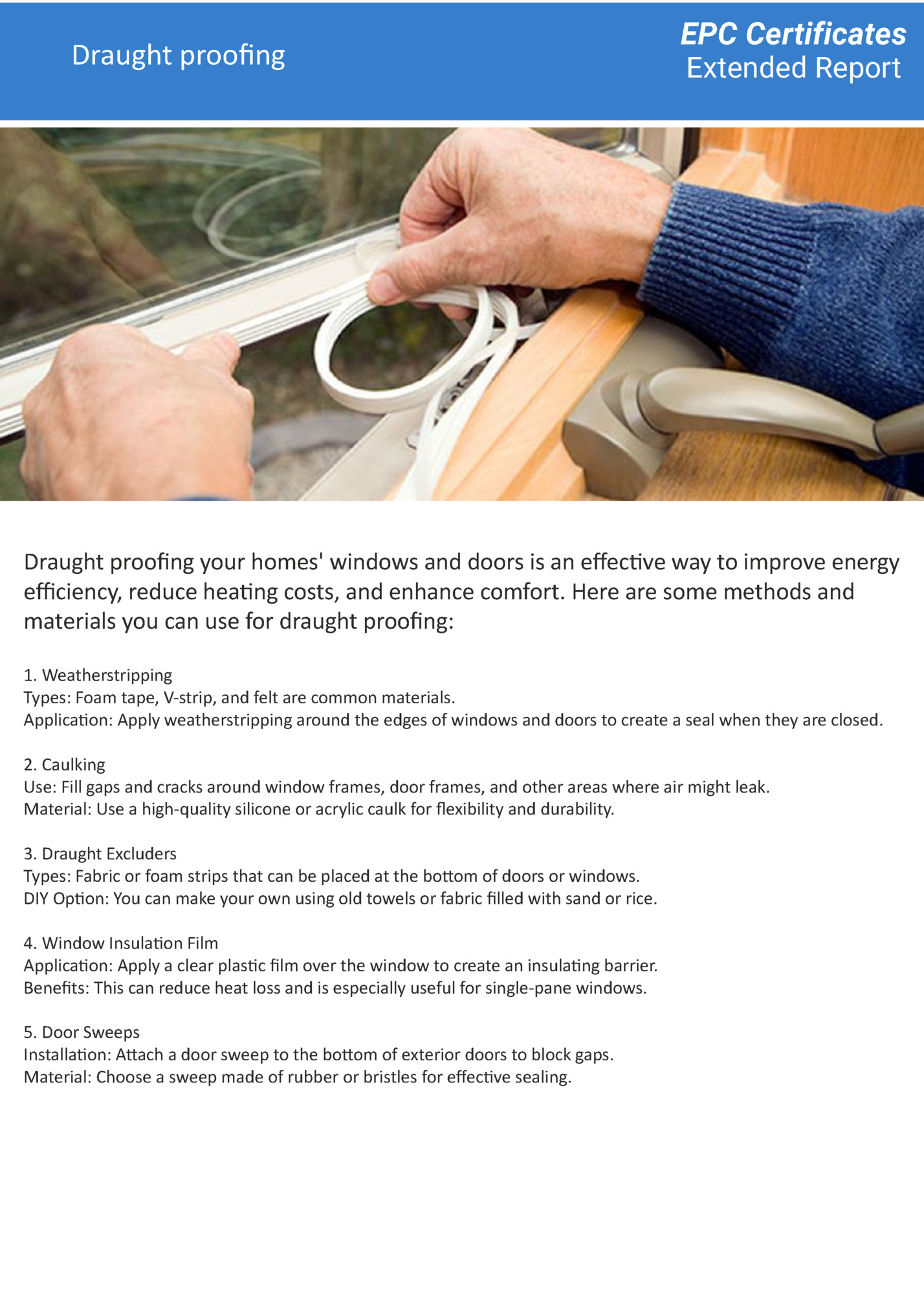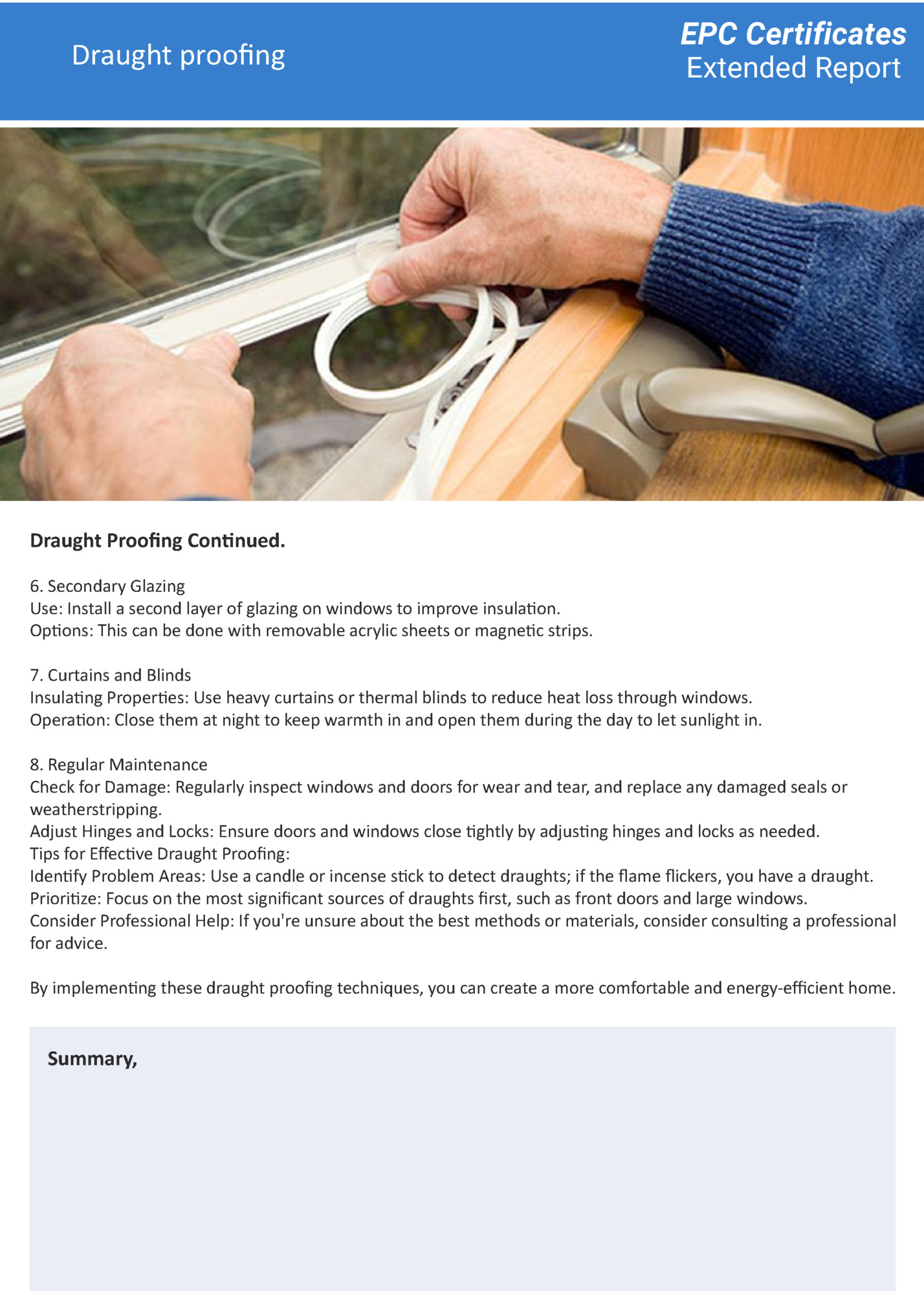Practicle help and guidance on how to improve the energy efficienbcy of your home. Reduce your fuel bills and increase the EPC rating to comply with proposed legislation. Extended EPC REPORT Report Collated: 25th March 2025

EPC Certificates Extended Report We have completed your report and trust you will find the information provided of erest, if we can be of further assistamnce, please do not hesitate to contact us. The report contains information on improvements that will help improve the energy efficiency of your property, these include improvements covering various budgetary requirements as well as information about grants and schemes that we are aware of and that may be available. The information has been compiled by registered and approved energy efficiency assessors following an assessment of the property by an approved assessor. The results have benn confirmed by assessing improvements within the government approved software and are deemed correct at time of calculation. Contents: Current Rating and Energy Efficiency of the Property Property profile, EPC overview, EPC potential and key findings Assumptions Important matters to consider Best route to C EPC rating Heating Controls - Zone Control (Mechanical and Electrical) After the assessment and following confirmation of our findings using the approved software we conclude that the most attractive way to acheive a "C" rating for your property would be to add "zone" controls to the heating system. Installation is usually carried out by a competant heating engineer or electricean and should be completed within a few hours with low disturbance to your tenants Grants Grants are not usually available for this as a stand-alone project and would usually rfequire householders to be receiving benefits to qualify. Quotations This job, whist fairly straight forward is not something heating engineers are requested to carry out very often, as such you may need to find an engineer who has experiance and who is willing to undertake the work at a reasonable cost We can help with quotations if requested.

Current Rating and Energy Efficiency of the Property Extended Report } Property Details Address 67 Ruscote Avenue, OX16 2NS Existing EPC Information Current Very energy efficient - lower running costs Date of Assessment 25th March 2025 (92 plus) Date of Compilation: 25th March 2025 (69-80) (81-91) (55-68) Existing EPC Expiry Date 15 June 2030 A 87 B C 67 D (39-54) Conservation area: Not Applicabe E (1-20) Council Tax Banding B Potential (21-38) F G Not energy efficient - higher running costs CO2-Emissions-Current 3.3 tonnes Existing EPC Rating D 67 CO2-Emissions-Potential 1.2 tonnes Potential EPC Rating B 87 Environment Impact Current 63 Property Estimated Built Age 1950 - 1966 Environment Impact Potential 85 Extension Estimated Built Age 2007 Key findings from your extended report The current EPC may not fully reflect your properties energy effieicency The property benefits from a condencing high efficiency combination boiler Insulation is assumed to be present in the rafters of the main property The walls of the main property are uninsulated The walls and sloping roof of the extension are likely to be insulated due to the consstruction age amd this information is reflected in the new assessment The property is double glazed throughout Wooden suspended floor to the main property deemed un-insulated The existing EPC rating of D currently complies with minimum energy efficiency standards but is below the proposed C rating that will be required

Innitial Findings Extended Report The following elements were identified during our initial assessment: Primary Heating: Boiler and radiators, mains gas Secondary Heating: No Secomdary Heating Heating Controls Programmer, room thermostat and TRV's Roof Construction/ Insulation Pitched, insulated at rafters Roof Construction/ Insulation (Extn. 1) Sloping, insulated (assumed) Wall Construction/ Insulation Solid, As Built Wall Construction/ Insulation (Extn.1) Cavity, Insulated (Assumed) Floor Construction/ Insulation Suspended, Timber, As Built Floor Construction/ Insulation (Extn. 1) Solid, Insulated (Assumed) We would recommend that you take the time to check the assumptions above to confirm that you have not carried out anything that perhaps the assessor was unable to see and incorporate in to the report.

Acheiving the C rating - Most cost effective route identified. Extended Report We consider the most cost effective way to acheive the required C rating would be to install the following improvements. Thie improvements listed have been added to a draft EPC assessment using the government approved software and the results are provided below. We have come to this conclusion based on our extensive knowledge based of years of experiance within the energy eficiency sector EPC Starting point D (67) Recommendation Zone Controls (mechanical & electrical) EPC Rating Acheived C (69) Indicative Cost £300 - £600 Grants Disruption New EPC Unlikely*** Low C (69) If you complete the above measures then your property should achieve an EPC of C or above.** The following measures are optional. All prices quoted are esiimates only for indicative purposes ** Grants and schemes may be available but may not cover the full cost and be subject to the EPC rating and council tax banding *** Grants and schemes may be available but may only be available to certain applicants in certain areas and part of a larger project and may be subject to the EPC rating or council tax banding.

Improvements to consider that would result in lower fuel bills and a warmer home. EPC Certificates Extended Report We have also considered further improvements that may be suitable, these could be considered as part of the current improvement plan or perhaps considered at a later date. Recommendation Photovoltaics (PV) Solid wall insulation Underfloor Insulation Internal wall insulation * Estimated Annual Saving* EPC Points New EPC Disruption Level Indicative Cost Energy Bill Saving* pa Cumulative Saving*

Existing Ventilation Extended Report When considering improvements to the thermal envelope of the property it is important to ensure that there is adequate ventilation. Moisture is generated as we live within our homes and ensuring that the property benefits from a ventialtion strategy is of primary importance. Existing Ventilation Identified Back-Ground Ventilation Not Assessed Purge Ventilation Not Assessed Passive Ventilation Not Assessed Extractor Fans Not Assessed If there are any signs of damp, particularly in the kitchen, bathrooms and around windows, we would always recommend having a ventilation assessment. Ideally, indoor air should have a relative humidity of between 40%-65%. We would recommend that Relative Humidity Controlled continuous extraction is installed in any bathrooms and the kitchen (eg, extractor fans).

EPC Certificates Extended Report Draught proofing your homes' windows and doors is an effective way to improve energy efficiency, reduce heating costs, and enhance comfort. Here are some methods and materials you can use for draught proofing: 1. Weatherstripping Types: Foam tape, V-strip, and felt are common materials. Application: Apply weatherstripping around the edges of windows and doors to create a seal when they are closed. 2. Caulking Use: Fill gaps and cracks around window frames, door frames, and other areas where air might leak. Material: Use a high-quality silicone or acrylic caulk for flexibility and durability. 3. Draught Excluders Types: Fabric or foam strips that can be placed at the bottom of doors or windows. DIY Option: You can make your own using old towels or fabric filled with sand or rice. 4. Window Insulation Film Application: Apply a clear plastic film over the window to create an insulating barrier. Benefits: This can reduce heat loss and is especially useful for single-pane windows. 5. Door Sweeps Installation: Attach a door sweep to the bottom of exterior doors to block gaps. Material: Choose a sweep made of rubber or bristles for effective sealing.

EPC Certificates Extended Report Draught Proofing Continued. 6. Secondary Glazing Use: Install a second layer of glazing on windows to improve insulation. Options: This can be done with removable acrylic sheets or magnetic strips. 7. Curtains and Blinds Insulating Properties: Use heavy curtains or thermal blinds to reduce heat loss through windows. Operation: Close them at night to keep warmth in and open them during the day to let sunlight in. 8. Regular Maintenance Check for Damage: Regularly inspect windows and doors for wear and tear, and replace any damaged seals or weatherstripping. Adjust Hinges and Locks: Ensure doors and windows close tightly by adjusting hinges and locks as needed. Tips for Effective Draught Proofing: Identify Problem Areas: Use a candle or incense stick to detect draughts; if the flame flickers, you have a draught. Prioritize: Focus on the most significant sources of draughts first, such as front doors and large windows. Consider Professional Help: If you're unsure about the best methods or materials, consider consulting a professional for advice. By implementing these draught proofing techniques, you can create a more comfortable and energy-efficient home. Summary,

Fleepit Digital © 2021